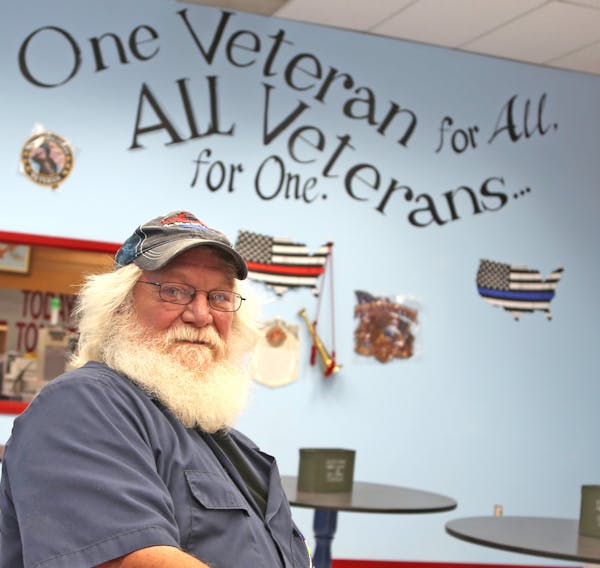Carlton, Minn. – While the St. Louis River quietly moved through its rocky gorge Wednesday within Jay Cooke State Park, the human flow around it was anything but quiet.
A mother and her two young kids searched for crayfish amid the craggy floor at the river's edge. A father and son arrived on their mountain bikes, and ditched them to investigate by foot downriver. In the sultry July air, parents with little ones found cool relief where the water pooled, while above groups of all sizes and ages took turns crossing the park's iconic Swinging Bridge.
Jay Cooke is one of the most visited of Minnesota's 75 state parks and recreation areas, but the scene, which included 30-plus vehicles in the park office lot, speaks to where people's heads are at in the season of COVID-19: It's outdoors. And during a big summer holiday week? Maybe more so.
The crowds also represent challenges for parks and trails managers, given the go-ahead to begin opening campgrounds June 1 — and to do it safely for staff and visitors. Some parks, particularly those close to metro areas, already were having unprecedented day traffic in April and May. Overnight visitors have added another layer of complexity.
Parks officials say they are working hard to catch up. About 85% percent of the state's 4,800 sites and lodges are open, and in some cases, each new week will bring new openings because maintenance needs were met or some safety protocol was nailed down. Beginning overnight Wednesday, camper cabins opened for use at Jay Cooke and two other parks, and about 60% of group sites systemwide now are usable.
"Our state parks and recreation areas are kind of like small cities," said Rachel Hopper, who coordinates visitor services and outreach for the parks and trails division of the Department of Natural Resources. "When they've been closed [in areas], it takes a while to get them up and running."
Hopper said the diversity of the parks means they operate differently, too. Because of their size or use, some need more staff than others, or have features like more campsites or facilities that demand more care. Hopper said sometimes the public asks why things look different in different locations, why something is opened at one and closed at another.
"We have 75 state parks and recreation areas and each one is unique," she said. "Each one has unique operational requirements, unique infrastructure and staffing needs."
Part of the strategy of opening up methodically, safely, means some things might stay closed. Protocols remain to minimize contact between staffers and visitors. What business must be handled at park offices usually is done through pay-as-you-go kiosks. Even buying firewood, a frequent need because outside wood must be certified, has moved to self-service at some places. Visitor centers where the public gathers to ask questions or make purchases are closed indefinitely. And some campsites will remain off limits because there isn't safe spacing between them, Hopper said.
Jay Cooke State Park Manager Lisa Angelos is short on seasonal staff, but the park is doing its best to accommodate the masses — including, now, campers. Just across the road from the park office, the campground was thick with all manner of recreational vehicles and tents, and will be through July 4th. All 80 sites are accounted for.
The park saw a 61.9% increase in day visitors alone in April from a year ago (19,838 to 32,055).
"The only reason Jay Cooke has been able to keep pace with this and offer the services we do is the incredible staff we have here, which fortunately are for the most part very experienced," Angelos said.
Recalling staff across the state has been delayed by a month or more. There are vacancies, too. Angelos has reallocated her charges. She has 13, six fewer than she did in June 2019. Some who normally work in the office, for example, have taken on more night and morning patrols.
"The primary concerns are maintaining public safety and meeting our cleaning demands and having our facilities safe and ready for the public to enjoy," she said.
Hopper said among the moves to help keep safe hundreds of full-time and seasonal staff members — wearing masks is mandatory — there are cleaning protocols that have affected the pace of openings. Parks with camper cabins have put in a 24-hour gap between use.
Visitors are encouraged to know "the key three" recommendations ahead of time, Hopper said. Check parks' individual websites in advance for updates on operations; come prepared and self-sufficient with items such as soap and hand sanitizer; and follow rules and signs, in some instances, tailored to parks. Signs stood at each end of the Swinging Bridge, encouraging people to navigate its narrow path a household at a time. People tried to comply.
Nabbing campsites
While the pandemic erased thousands of reservations, overall to date 50% of the system's campsites and lodges are reserved for July, and 78% percent on weekends. Parks are almost 86% full through the holiday, added Hopper, who said the weekend's totals likely will be close to 2019, knowing some campers reserve spots just two weeks out. Last year, 89% of the parks' sites were filled on the July 4th holiday. In a normal year, more than 1 million people camp overnight in the system.
A young family from south Minneapolis lazed around a wooded campsite at Jay Cooke early Wednesday. They were glad to have it. Tom McLafferty, 38, said the pandemic had canceled vacation options for him, his wife, Ana, and their three children. Normally they might have headed to a lake resort. Camping was a good option, and the timing was right: They're both teachers and off in the summer. There were few spots left at Jay Cooke when they made a reservation three weeks ago.
Poking at a smoky fire with his son Tommy, 5, nearby, McLafferty said they all have stuck close to home during the pandemic, with backyard play and nature walks in the metro.
Public health appeared to still be on top of their mind. The McLaffertys said they've been a little wary of enclosed areas like the camp restroom. "I've been seeing signs up so that's a good sign," said Ana McLafferty, 36. They, like the park manager, have noticed how few people in camp are covering their faces.
"There are not a lot of people utilizing masks," Angelos said. "It seems that the public is doing its best to keep distances from one another, but it is very crowded. So the mask use certainly helps."
Still, the McLaffertys appeared to enjoy their last full day in the distinct beauty of this part of Carlton County.
"You're all about it, right?" Tom asked Ana.
"Yeah, I love it. I was like, 'We have to do this at least once more this summer.' This is so fun," said Ana, as she kicked back on an air mattress, joined at different times by their daughter, Mary, 7, or other son, Adam, 3.
Joe and Carol Syring of Hugo embraced camping long before the pandemic put a clamp on everyday life. They were on their fourth trip in the last few years to a Minnesota state park — and second to Jay Cooke — with their 16-foot Scamp and their chow-shepherd mix, Pete. The semiretired couple also have plans for a longer trip with a nephew and niece to Itasca.
Like the McLaffertys, they felt fortunate to nab one of the few sites left at the park online. Campers filled almost 94% of Jay Cooke's sites in June, a sign of things to come.
The grip of the pandemic hadn't reached them here. They said they felt comfortable and safe at Jay Cooke.
"People are really good. They just say, 'Hi.' They don't get in your face when you camp," Carol Syring said.
"I love it that the state park ranger comes by. They're respectful," her husband added. "I have no complaints about the state park system."
Bob Timmons • 612-673-7899

Twins lose second in a row to Blue Jays as bullpen falters late

The PWHL's growth comes with a price for a Minnesota Frost team building a potential dynasty
What is the 'House settlement,' and what does it mean for the Gophers and NCAA?

Souhan: Anxiety and depression in the NFL helped inspire Lindsey Young's children's book

